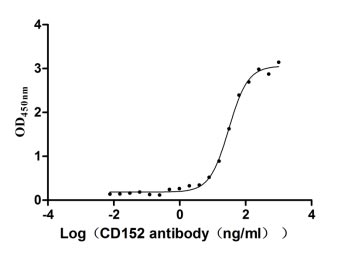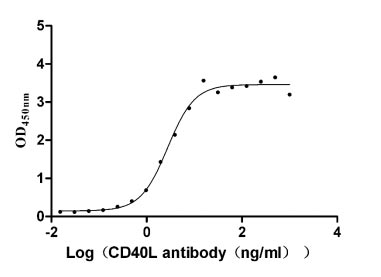Recombinant Human Cleavage and polyadenylation specificity factor subunit 6 (CPSF6)
-
货号:CSB-YP621966HU
-
规格:
-
来源:Yeast
-
其他:
-
货号:CSB-EP621966HU
-
规格:
-
来源:E.coli
-
其他:
-
货号:CSB-EP621966HU-B
-
规格:
-
来源:E.coli
-
共轭:Avi-tag Biotinylated
E. coli biotin ligase (BirA) is highly specific in covalently attaching biotin to the 15 amino acid AviTag peptide. This recombinant protein was biotinylated in vivo by AviTag-BirA technology, which method is BriA catalyzes amide linkage between the biotin and the specific lysine of the AviTag.
-
其他:
-
货号:CSB-BP621966HU
-
规格:
-
来源:Baculovirus
-
其他:
-
货号:CSB-MP621966HU
-
规格:
-
来源:Mammalian cell
-
其他:
产品详情
-
纯度:>85% (SDS-PAGE)
-
基因名:CPSF6
-
Uniprot No.:
-
别名:CFIM; CFIm68; cleavage and polyadenylation specific factor 6; 68kDa; Cleavage and polyadenylation specificity factor 68 kDa subunit; Cleavage and polyadenylation specificity factor subunit 6; cleavage factor Im complex 68 kDa subunit; CPSF 68 kDa subunit; Cpsf6; CPSF6_HUMAN; HPBRII 4; HPBRII 7; Pre mRNA cleavage factor Im 68 kDa subunit; pre-mRNA cleavage factor I; 68kD subunit; pre-mRNA cleavage factor Im (68kD); Pre-mRNA cleavage factor Im 68 kDa subunit; Protein HPBRII 4/7; Protein HPBRII-4/7
-
种属:Homo sapiens (Human)
-
蛋白长度:full length protein
-
表达区域:1-551
-
氨基酸序列MADGVDHIDI YADVGEEFNQ EAEYGGHDQI DLYDDVISPS ANNGDAPEDR DYMDTLPPTV GDDVGKGAAP NVVYTYTGKR IALYIGNLTW WTTDEDLTEA VHSLGVNDIL EIKFFENRAN GQSKGFALVG VGSEASSKKL MDLLPKRELH GQNPVVTPCN KQFLSQFEMQ SRKTTQSGQM SGEGKAGPPG GSSRAAFPQG GRGRGRFPGA VPGGDRFPGP AGPGGPPPPF PAGQTPPRPP LGPPGPPGPP GPPPPGQVLP PPLAGPPNRG DRPPPPVLFP GQPFGQPPLG PLPPGPPPPV PGYGPPPGPP PPQQGPPPPP GPFPPRPPGP LGPPLTLAPP PHLPGPPPGA PPPAPHVNPA FFPPPTNSGM PTSDSRGPPP TDPYGRPPPY DRGDYGPPGR EMDTARTPLS EAEFEEIMNR NRAISSSAIS RAVSDASAGD YGSAIETLVT AISLIKQSKV SADDRCKVLI SSLQDCLHGI ESKSYGSGSR RERSRERDHS RSREKSRRHK SRSRDRHDDY YRERSRERER HRDRDRDRDR ERDREREYRH R
-
蛋白标签:Tag type will be determined during the manufacturing process.
The tag type will be determined during production process. If you have specified tag type, please tell us and we will develop the specified tag preferentially. -
产品提供形式:Lyophilized powder
Note: We will preferentially ship the format that we have in stock, however, if you have any special requirement for the format, please remark your requirement when placing the order, we will prepare according to your demand. -
复溶:We recommend that this vial be briefly centrifuged prior to opening to bring the contents to the bottom. Please reconstitute protein in deionized sterile water to a concentration of 0.1-1.0 mg/mL.We recommend to add 5-50% of glycerol (final concentration) and aliquot for long-term storage at -20℃/-80℃. Our default final concentration of glycerol is 50%. Customers could use it as reference.
-
储存条件:Store at -20°C/-80°C upon receipt, aliquoting is necessary for mutiple use. Avoid repeated freeze-thaw cycles.
-
保质期:The shelf life is related to many factors, storage state, buffer ingredients, storage temperature and the stability of the protein itself.
Generally, the shelf life of liquid form is 6 months at -20°C/-80°C. The shelf life of lyophilized form is 12 months at -20°C/-80°C. -
货期:Delivery time may differ from different purchasing way or location, please kindly consult your local distributors for specific delivery time.Note: All of our proteins are default shipped with normal blue ice packs, if you request to ship with dry ice, please communicate with us in advance and extra fees will be charged.
-
注意事项:Repeated freezing and thawing is not recommended. Store working aliquots at 4°C for up to one week.
-
Datasheet :Please contact us to get it.
相关产品
靶点详情
-
功能:Component of the cleavage factor Im (CFIm) complex that functions as an activator of the pre-mRNA 3'-end cleavage and polyadenylation processing required for the maturation of pre-mRNA into functional mRNAs. CFIm contributes to the recruitment of multiprotein complexes on specific sequences on the pre-mRNA 3'-end, so called cleavage and polyadenylation signals (pA signals). Most pre-mRNAs contain multiple pA signals, resulting in alternative cleavage and polyadenylation (APA) producing mRNAs with variable 3'-end formation. The CFIm complex acts as a key regulator of cleavage and polyadenylation site choice during APA through its binding to 5'-UGUA-3' elements localized in the 3'-untranslated region (UTR) for a huge number of pre-mRNAs. CPSF6 enhances NUDT21/CPSF5 binding to 5'-UGUA-3' elements localized upstream of pA signals and promotes RNA looping, and hence activates directly the mRNA 3'-processing machinery. Plays a role in mRNA export.; (Microbial infection) Binds HIV-1 capsid-nucleocapsid (HIV-1 CA-NC) complexes and might thereby promote the integration of the virus in the nucleus of dividing cells (in vitro).
-
基因功能参考文献:
- The s demonstrate that CFIm functions as an enhancer-dependent activator of mRNA 3' processing. CFIm regulates global alternative polyadenylation by specifically binding and activating enhancer-containing poly(A) sites. PMID: 29276085
- High CPSF6 expression is associated with HIV infections. PMID: 29643241
- we found CPSF6 and all core paraspeckles proteins to be overexpressed in human breast cancer cases and their expression to correlate with poor patient outcomes. PMID: 28673861
- Studies suggest that binding of cleavage factor Im (CFIm) may be one of the earliest steps in promoting formation of an active cleavage complex. PMID: 27528751
- CPSF6 binding to its docking site in HIV-1 capsid leads to the recruitment of CFIm tetramer, suggesting that CFIm mediates CPSF6 function(s) in integration site targeting. PMID: 26994143
- integration targeting proceeds via two distinct mechanisms: capsid-CPSF6 binding directs HIV-1 to actively transcribed euchromatin, where the integrase-LEDGF/p75 interaction drives integration into gene bodies. PMID: 26858452
- Structural basis of HIV-1 capsid recognition by PF74 and CPSF6. PMID: 25518861
- study uncovers two opposing CA-dependent functions of CPSF6 in HIV-1 replication in vivo; however, the benefit for binding CPSF6 appears to outweigh the cost, providing support for a vital function of CPSF6 during HIV-1 replication in vivo PMID: 24415937
- CPSF6 binds specifically to a novel proteinprotein interface on the N-terminal domain of HIV-1 capsid protein (CA). PMID: 22956906
- These results suggested that inhibition of HIV-1 by TNPO3-depleted cells requires CPSF6. PMID: 23622145
- Loss-of-function of CFIm68 and CFIm25 leads to a transcriptome-wide increase in the use of proximal polyadenylation sites in HEK293 cells. PMID: 23187700
- TNPO3 promotes HIV-1 infectivity indirectly, by shifting the CA-binding protein CPSF6 to the nucleus, thus preventing the excessive HIV-1 CA stability that would otherwise result from cytoplasmic accumulation of CPSF6. PMID: 23414560
- A carboxy-terminally truncated human CPSF6 lacking residues encoded by exon 6 inhibits HIV-1 cDNA synthesis and promotes capsid disassembly. PMID: 23658440
- Knockdown of CF I(m)68 induced a systematic use of proximal polyadenylation sites, indicating that changes in relative abundance of a single 3' end processing factor can modulate the length of 3' untranslated regions across the transcriptome. PMID: 22813749
- A 9-residue stretch of hydrophobic amino acids in CPSF6 restricts HIV-1 infection through an interaction with capsid. PMID: 22301135
- The study reports the crystal structure of human cleavage factor I(m), comprising cleavage factor I(m)25 and the RNA recognition motif domain of cleavage factor I(m)68 kDa (CF I(m)68RRM). PMID: 21483454
- Crystal structure of CFIm25-CFIm68 RRM heterotetramer illustrated that CFIm25 homodimer is clamped by two CFIm68 monomers on each side of the dimer interface PMID: 21295486
- Structure of a CFI(m)25/CFI(m)68 RRM heterotetramer and biochemical data indicated that CFIm25 specifically recognized two UGUA elements, CFIm68 facilitates looping of the intervening RNA. CFIm-mediated RNA looping may regulate alternative polyadenylation PMID: 21295486
- HIV-1 harboring the N74D mutation in capsid protein fails to interact with CPSF6 and evades the nuclear import restriction. PMID: 20227665
- These results reveal a novel function for the pre-mRNA 3' end processing factor CF I(m)68 in mRNA export. PMID: 19864460
- Data show that cleavage factor I(m) can stimulate both cleavage and poly(adenine) addition, and can act to suppress poly(A) site cleavage in a sequence-dependent manner. PMID: 14690600
- a direct role of the U2AF 65/CF I(m) 59 interaction in the functional coordination of splicing and 3' end processing. PMID: 17024186
- CF Im68 subnuclear distribution and mobility PMID: 17267687
- Key paper demonstrating mechanism of CF Im binding to CPSF. Also challenges the long standing perception of mammalian mRNA 3'-end processing that insists that mammalian poly (A) sites are determined by two sequence elements alone. PMID: 15937220
- Elevated levels of human cleavage factor Im suppressed cleavage at the primary poly(A) site of the pre-mRNA encoding the 68 kDa subunit of CFI(m). PMID: 14690600
显示更多
收起更多
-
亚细胞定位:Nucleus. Nucleus, nucleoplasm. Nucleus speckle. Cytoplasm.
-
蛋白家族:RRM CPSF6/7 family
-
数据库链接:
HGNC: 13871
OMIM: 604979
KEGG: hsa:11052
STRING: 9606.ENSP00000391774
UniGene: Hs.369606
Most popular with customers
-
Recombinant Human Cytotoxic T-lymphocyte protein 4 (CTLA4), partial (Active)
Express system: Mammalian cell
Species: Homo sapiens (Human)
-
Recombinant Human CD40 ligand (CD40LG), partial (Active)
Express system: Mammalian cell
Species: Homo sapiens (Human)
-
Recombinant Human Tyrosine-protein kinase Mer (MERTK), partial (Active)
Express system: Mammalian cell
Species: Homo sapiens (Human)
-
Recombinant Human Nectin-4 (NECTIN4), partial (Active)
Express system: Mammalian cell
Species: Homo sapiens (Human)
-
Recombinant Human Claudin-18.2 (CLDN18.2)-VLPs (Active)
Express system: Mammalian cell
Species: Homo sapiens (Human)
-
Recombinant Human Tissue factor pathway inhibitor (TFPI), partial (Active)
Express system: Mammalian cell
Species: Homo sapiens (Human)
-
Recombinant Human Carcinoembryonic antigen-related cell adhesion molecule 6 (CEACAM6) (Active)
Express system: Mammalian cell
Species: Homo sapiens (Human)
-
Recombinant Human Serine/threonine-protein kinase receptor R3 (ACVRL1), partial (Active)
Express system: Baculovirus
Species: Homo sapiens (Human)






-AC1.jpg)













